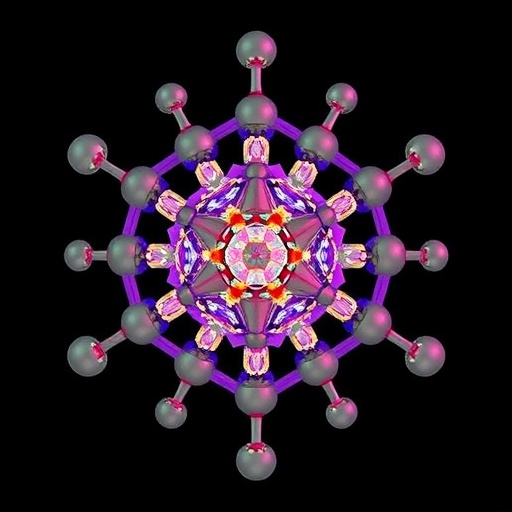In a groundbreaking advancement poised to reshape magnetic refrigeration technologies and low-temperature physics, researchers at Tokyo University of Science have unveiled a novel approach to engineer magnetocaloric materials by transcending long-standing stoichiometric limitations. Led by Professor Ryuji Tamura and Assistant Professor Farid Labib, the team’s innovative “double hetero-valent elemental substitution” technique enables fine-tuning of magnetic properties in quasicrystal approximants via precise control over their valence electron concentration, significantly enhancing their magnetocaloric response.
Traditional stoichiometric compounds, defined by fixed elemental ratios, inherently restrict the tunability of electronic and magnetic characteristics due to their compositional rigidity. This constraint is particularly pronounced in complex intermetallic systems such as quasicrystals (QCs) and their structurally related approximant crystals (ACs), where electronic properties are exquisitely sensitive to the valence electron-per-atom ratio (e/a). QCs typically maintain structural stability within a narrow e/a window of approximately 2.00. Attempts to deviate from this range often destabilize the structure, limiting exploratory avenues for materials design.
The newly reported work, published in the Journal of the American Chemical Society on August 27, 2025, confronts this challenge by introducing controlled partial substitutions of atoms with others that carry different valence electrons but share comparable atomic radii and chemical behaviors. This “double hetero-valent elemental substitution” method strategically replaces gallium (Ga) and platinum (Pt) within the prototypical stoichiometric Ga₅₂Pt₃₄Gd₁₄ 2/1 approximant crystal. By incorporating gold (Au) atoms, the researchers effectively expand the compositional domain, creating non-stoichiometric quaternary Ga–Pt–Au–Gd 1/1 approximant crystals with a broader e/a range spanning 1.60 to 1.83, a remarkable departure from the stoichiometric e/a of 1.98.
The implications of this development are profound. The non-stoichiometric crystals do not merely retain their structural integrity; they exhibit a complete transformation in magnetic behavior. While the original stoichiometric compound displays spin-glass-like freezing — a hallmark of magnetic frustration and disordered spin states — the substituted samples demonstrate robust long-range ferromagnetic ordering. These new phases undergo second-order magnetic phase transitions characterized by mean-field-like critical phenomena, with Curie temperatures adjustable between 8.7 K and 14.9 K depending on the precise elemental composition. This tunability offers an unprecedented lever over the materials’ low-temperature magnetic dynamics.
Of particular technological interest is the enhancement of the magnetocaloric effect, a key property leveraged in magnetic refrigeration. This phenomenon, whereby a material heats up or cools down upon exposure or removal of a magnetic field, is quantified by the isothermal magnetic entropy change (ΔSₘ). The novel Ga–Pt–Au–Gd quaternary approximants achieve ΔSₘ values reaching −8.7 J/K·mol-Gd — rivaling the best-performing rare-earth-based magnetocaloric materials known to date. Such strong magnetocaloric responses showcase these compounds as promising candidates for next-generation refrigeration devices operating at cryogenic temperatures.
The research team emphasizes the versatility of their substitution framework. By selecting pairs of elements with similar atomic characteristics — for example, copper/magnesium, calcium/lead, or silver/palladium — the approach can be generalized beyond the Ga–Pt–Au–Gd system. This flexibility opens pathways for customizing magnetocaloric materials with tailored transition temperatures and magnetic performance, potentially extending the concept to broader families of quasicrystals and intermetallic compounds.
This new synthetic strategy not only pushes the frontiers of magnetic materials science but also offers practical benefits. By replacing costly precious metals like platinum and gold with more abundant and cheaper alternatives such as copper or silver, the method could accelerate the commercialization of magnetocaloric technologies. Economical scalability ensures real-world applicability in fields demanding efficient cryogenic cooling solutions.
Low-temperature refrigeration remains critical for diverse domains, ranging from quantum computing to medical diagnostics. Techniques such as adiabatic demagnetization refrigeration (ADR) rely on materials with strong magnetocaloric effects at sub-15 K temperatures. The newly synthesized compounds’ transition temperatures and magnetocaloric strengths position them as prime candidates for such applications, potentially enabling helium-free, high-capacity magnetic regenerators — a significant advance given the global scarcity and cost of helium.
Moreover, the enhanced volumetric entropy capacity achievable through the engineered magnetic phase transitions could lead to compact, energy-efficient cryogenic devices. These gains are particularly relevant in emerging quantum technologies where stable, ultra-low temperature environments are crucial for device coherence and operational fidelity.
Beyond immediate technological impacts, the study illuminates fundamental scientific insights into the relationship between electronic structure and magnetism in complex materials. By circumventing stoichiometric constraints, it becomes possible to probe and manipulate magnetic frustration, phase transitions, and electron correlation effects in previously inaccessible regimes, enriching our understanding of quasicrystal approximants and related systems.
Professor Tamura asserts that this work represents a paradigm shift. “Our double hetero-valent elemental substitution approach unveils a new dimension in designing magnetic materials. Turning stoichiometrically rigid compounds into tunable, non-stoichiometric systems unlocks myriad possibilities for magnetic refrigeration and beyond,” he notes. This transformative strategy heralds a new horizon in material innovation, poised to influence both fundamental research and practical technologies.
In summary, this pioneering research not only showcases an elegant solution to a long-standing chemical and physical constraint but also charts a promising course toward the rational design of magnetocaloric materials with tailored properties. As demands for efficient, environmentally friendly cooling escalate, materials engineered through such innovative substitution methods could become indispensable components of future cryogenic and quantum technologies.
Subject of Research:
Not applicable
Article Title:
Derivation of a non-stoichiometric 1/1 quasicrystal approximant from a stoichiometric 2/1 quasicrystal approximant and maximization of magnetocaloric effect
News Publication Date:
27-Aug-2025
References:
DOI: 10.1021/jacs.5c05947
Image Credits:
Credit: Prof. Ryuji Tamura from Tokyo University of Science, Japan
Keywords
Ferromagnetism, Materials science, Condensed matter physics, Magnetism, Quasicrystals, Quantum computing, Low temperature physics, Thermal energy, Entropy, Materials processing




